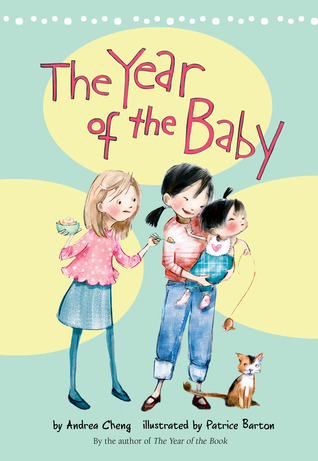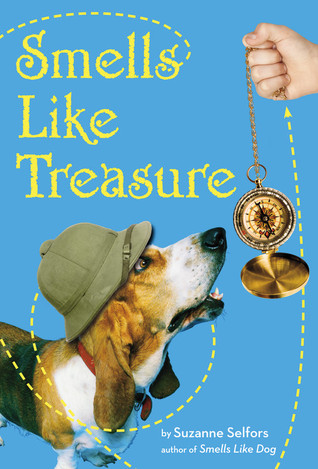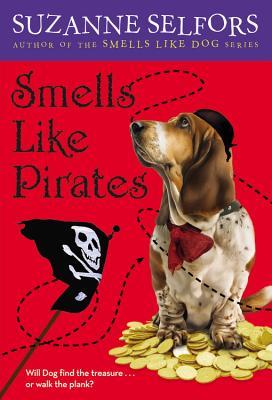I think I have found yet another favorite read this past month and a half. It is the Smells Like Dog book series by Suzanne Selfors.
BIBLIOGRAPHY
Selfors, Suzanne. 2010.
Smells Like Dog. NY: Little, Brown Books for Young Readers. ISBN: 9870316043984.
Selfors, Suzanne. 2011.
Smells Like Treasure. NY: Little, Brown Books for Young Readers. ISBN:
9780316043991.
Selfors Suzanne. 2012. Smells Like Pirates. NY: Little, Brown Books for Young Readers. ISBN: 9780316215756.
BOOK REVIEW
Homer W. Pudding is not necessarily your average twelve-year-old boy. He's a little chunky, he loves maps, and he dreams of being a treasure hunter like his Uncle Drake. The other kids at his one-room school (he lives in a small country town) all make fun of him. Living on his father's goat farm where he has chores isn't much of a treasure-hunter's way of life either. His father is a grouchy goat farmer (who has lives with dashed dreams), his bossy older sister (who has a pension for road kill and taxidermy) is always embarrassed by him, but his mother and little brother Squeak love him unconditionally (his father and sister do too, really). In the first book
Smells Like Dog, not too longer after sharing the secret that he had found the map to the world's most famous pirate Rumpold Smeller's most coveted treasure, Uncle Drake is tragically and puzzlingly swallowed whole by a turtle at The City Zoo, and Homer inherits his "most treasured possession." But is it the basset hound named Dog who cannot smell a single thing or is it the coin found on his collar that has word L.O.S.T. on it? During a trip to The City and the Museum of Natural History, which is where he meets his first enemy Madame le Director, the adventure begins to solve mystery of what happened to Uncle Drake, where did all his belongings disappeared to, what does the coin mean, and why did Uncle Drake have a dog that cannot smell? With the help of his new friend Lorelei, Homer enters a whole new world as that he has always dreamed of. Full of twist and turns, readers will feel the excitement, hurt and betrayal (sometimes friends have secret motives and will stab you in the back, per say), and triumph right along with Homer and Dog.
Smells Like Treasure, the second book in the series, starts off a few months after the first one ended. Homer is back in Milkydale at the farm when he gets the notification that L.O.S.T. (the
Society of Legends, Objects, Secrets, and Treasures), a secret society of treasure hunters, has called a meeting to discuss Homer inheritance of his Uncle Drake's chair in the group. His friends and fellow members of L.O.S.T., extremely tall Zelda and and inventor Ajitabh, are on his side, but other members are skeptical for allowing such a young member into the group let alone if he truly was rightful heir to the empty position. Then, all of sudden, Lorelei enters to claim the empty spot stating that she has the coin of membership. Now, Homer and Lorelei must put the treasure-hunter skills to the test and be the first person to find the hidden membership coin to claim their rightful place in the society. The introduction to the rest of the L.O.S.T. members expands Homer and readers' world. Fellow member, and teenager, Hercules is a humorous and delightful hypochondriac character to meet that readers will greatly enjoy. This book is also laced with a few chapters about the history of Rumpold Smeller and how "he" became a pirate, which is very important to learn when you read the third book.
In the third book
Smells Like Pirates Homer faces yet another hurdle soon after becoming a bonafide member of the L.O.S.T.. While at meeting to determine the new president of the society, it was announced that Lorelei has gotten ahold of Rumpold Smeller's map, which should have been safely hidden under Homer's bed back in Milkydale, and looks to claim the treasure for FOUND (her own treasure hunting society). Now, he and his friend/adversary have a gentleman's agreement to search for the treasure and split it 50/50. Hercules follows to record the hunt, especially to prove that Homer has not betrayed L.O.S.T. like other members. All turns out well in the end, which is such a relief! New treasure has been discovered, friendships rebuilt, and new discoveries that will lead to new adventures for our dynamic duo, which could possibly turn into the terrific trio. Readers also learn that Lorelei has a famous treasure-hunting lineage, that she and Homer are still unaware of, and which the readers will love!
All three of these books have solid, well rounded characters that you will instantly love or hate or be suspicious of. Every single one of them have distinct qualities and characteristics that sets them apart from any other. Homer himself is an upstanding fellow who has an amazing qualities and feelings. Even though horrible things could happen and he feels the betrayal of close to him he can still put any ill feelings aside to work with the person or to refrain from saying things at the wrong time. All readers will fall in love with Dog and will connect to the attachment between Homer and Dog. When betrayal, distrust, a plotting scheme occurs that throws Homer's plans in a momentary spin, the readers will feel it, especially when Dog is "borrowed" on a couple of occasions. Another great element of this book is the use of Greek mythology, such as
The Odyssey.
Though the books could each stand stand alone, I highly recommend starting from the beginning to get all the back story.
Smells Like Pirates ends with just enough information that leaves readers with the hope for a fourth book. I'm ready for more Smells Like Dog books! And maybe my own basset hound.
CONNECTIONS
- Have the children explore the realm of cartography! Allow them to learn how to read a map properly.
- Let the children create their own map!
- Explore books about lost treasures. Allow the children to create their own hypothesis of where the treasures would be located today.
- If the children were a member of L.O.S.T. what would they be like? Would they be an inventor like Ajitabh? What would their official treasure hunting outfit would be?
- Have the children compare elements of the book series to the Odyssey.




